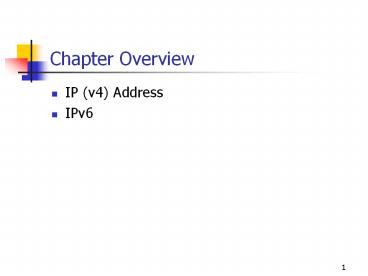Chapter%20Overview - PowerPoint PPT Presentation
Title:
Chapter%20Overview
Description:
Chapter Overview IP (v4) Address IPv6 * * IPv4 Addresses Internet Protocol (IP) is the only network layer protocol with its own addressing system and is design for a ... – PowerPoint PPT presentation
Number of Views:231
Avg rating:3.0/5.0
Title: Chapter%20Overview
1
Chapter Overview
- IP (v4) Address
- IPv6
2
IPv4 Addresses
- Internet Protocol (IP) is the only network layer
protocol with its own addressing system and is
design for a host on one network to communicate
with another host on a different network,
regardless the type of LAN - IP addresses are 32 bits long and have two parts
a network identifier and a host identifier. - IP addresses are assigned to network interface
adapters, not to computers. - The Source IP Address field in the IP header
always identifies the computer that generated the
packet. - The Destination IP Address field in the IP header
always identifies the packets final destination.
3
ipconfig
4
IP Address Assignments
- Every network interface adapter on a network must
have - The same network identifier as the others on the
network - A unique host identifier
- The Internet Assigned Numbers Authority (IANA)
assigns network identifiers, but you typically
obtain network addresses from an Internet service
provider (ISP). - Network administrators, or DHCP, assign host
identifiers.
5
- Dotted decimal
- For example,
- 124.241.144.2
- This is not one
- 1.1.1.256
- The binary and hexadecimal are not common to say
the least
6
IP Address Classes
7
IP Address Class First Bit/Byte Values
Class First Bits First Byte Values
A 0 1127
B 10 128191
C 110 192223
Class D (224-239) and E (240-255)
8
IP Address Class Network and Host Bits
Class Network ID Bits Host ID Bits Number of Networks Number of Hosts
A 8 24 126 16,777,214
B 16 16 16,384 65,534
C 24 8 2,097,152 254
9
Private Network Addresses
Class Network Addresses
A 10.0.0.0 through 10.255.255.255
B 172.16.0.0 through 172.31.255.255
C 192.168.0.0 through 192.168.255.255
10
IP Addressing Rules
- All the bits in the network identifier cannot be
set to zeros. - All the bits in the network identifier cannot be
set to ones. - All the bits in the host identifier cannot be set
to zeros. - All the bits in the host identifier cannot be set
to ones.
11
Reserved IP addresses
12
Automatic Private Internet Protocol Addressing
(APIPA)
- a common alternative to the use of DHCP to
request and retrieve an IP address for a host. - simplifies the assignment of IP address and
subnet-mask configuration information to hosts in
small networks. - When APIPA is used, the OS allows the assignment
of a unique IP address to each station on a small
LAN to avoids the administrative overhead of
running a DHCP server or manually setting IP
configuration information.
13
Different types of broadcasts
- Layer 2 broadcast -- all nodes on a LAN
- Broadcast (Layer 3) to all hosts on the network
- Unicast a node sends a message to
255.255.255.255 with port number 67 (BootP
server), router knows it is for DHCP asking for
an IP address, so forward to DHCP server - Multicast one host to several hosts, forwarded
by router
14
IPv6 Addressing
- Expands IP address space from 32 to 128 bits
- Designed to prevent the depletion of IP addresses
and address-exhaustion crisis of IPv4, later
modified to add features for flexibility,
efficiency, capability, mobility, etc - Uses XXXXXXXXXXXXXXXX notation, each X is
a pair of hexadecimals
15
IPv6 Addressing (2)
- Global routing prefix used by router for the
network - A subset of a network
- A host address
16
IPv6 Addressing (3)
- You can only replace one contiguous block of
zeros in an address
17
IPv6 Address Types
- Unicast very much the same as IPv4 unicast
- Global unicast unicast, start with 001
- Link-local address -- private, not to be routed
(FE80 addresses) for point to point, not
forwarded - Unique local address -- FC00/
- Multicast to all
- Anycast -- to one
18
Special address
- 00000000 same as 0.0.0.0 in IPv4 not
for communication - 00000001 1 same as 127.0.0.1 for
loopback - 000000192.168.100.1 mixing IPv4 with IPv6
- 200/3 global unicast address range
- FC00/7 unique local unicast range
- EF80/10 link-local unicast range
- FF00/8 The multicast range
- 3FFFFFFF/32 and 20010DB8/32 for examples
and document - 2002/16 for 6 to 4
19
2002/16 for 6 to 4
- For any 32-bit global IPv4 address, a 48-bit 6to4
IPv6 prefix can be constructed for use by that
host (and if applicable the network behind it) by
prepending 2002 (hex) to the IPv4 address. - For example, for192.0.2.42, the corresponding
6to4 prefix would be 2002c000022a/48. - This gives a prefix length of 48 bits, which
leaves room for a 16-bit subnet field and a 64
bit host address within the subnet.






























